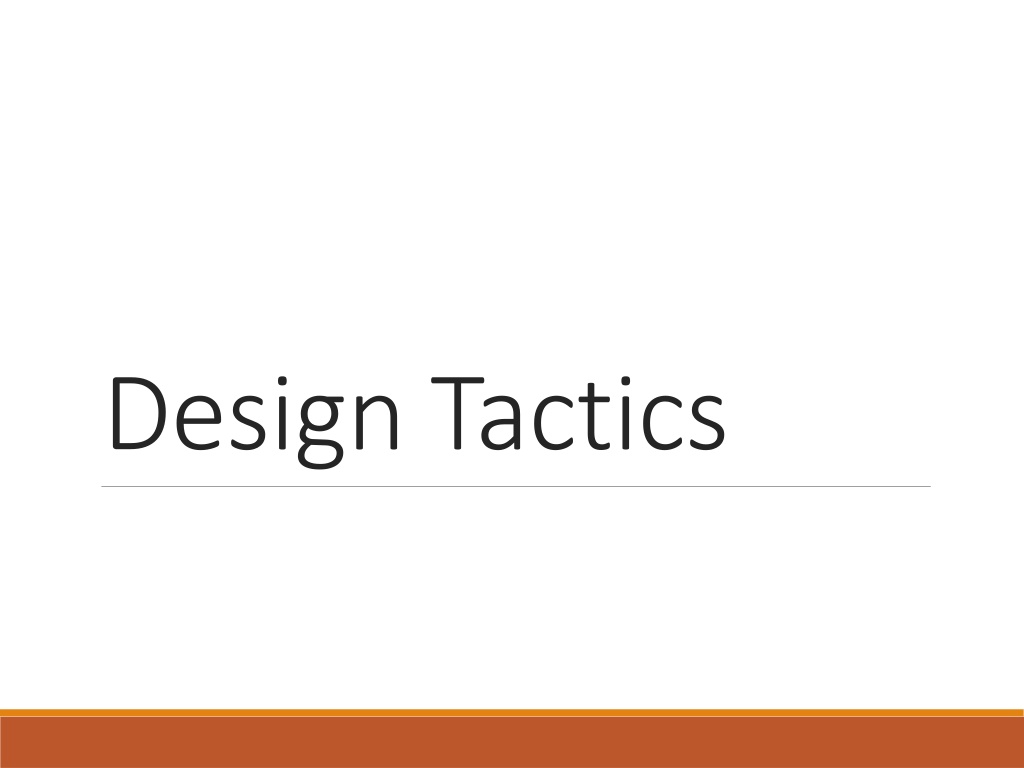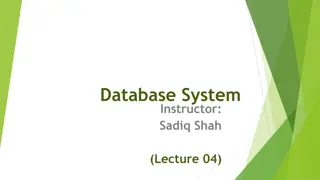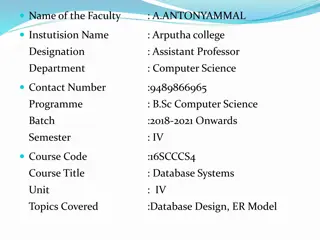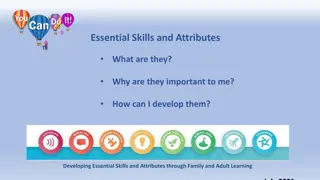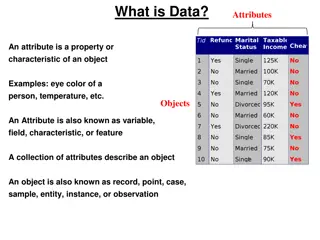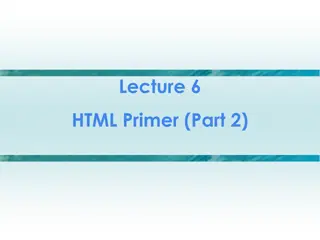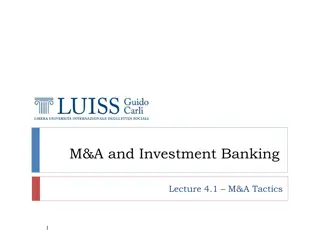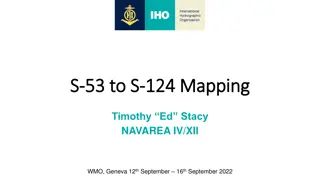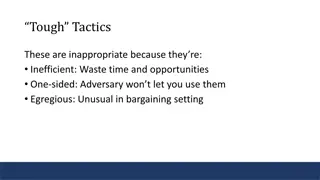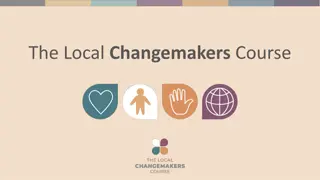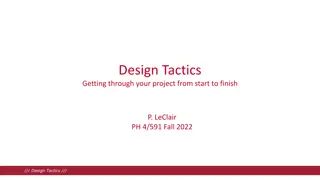Understanding Design Tactics and Quality Attributes
Quality attributes play a crucial role in system design by indicating how well a system meets stakeholder needs. Architecturally Significant Requirements (ASRs) have a profound impact on system architecture. Quality attributes can be operational (availability, reliability) or developmental (modifiability, testability). Patterns offer strategies for addressing system problems, while tactics are lower-level design decisions to achieve quality attribute responses. Explore the relationships between tactics and patterns, especially in achieving modifiability. Learn how tactics can enhance patterns by mitigating weaknesses, ultimately optimizing system design.
Download Presentation

Please find below an Image/Link to download the presentation.
The content on the website is provided AS IS for your information and personal use only. It may not be sold, licensed, or shared on other websites without obtaining consent from the author. Download presentation by click this link. If you encounter any issues during the download, it is possible that the publisher has removed the file from their server.
E N D
Presentation Transcript
First, lets take a step back Quality Attribute: A measurable or testable property of a system that is used to indicate how well the system satisfies the needs of its stakeholders. Architecturally Significant Requirement (ASR): A requirement that will have a profound effect on the architecture that is the architecture may be significantly different in the absence of this requirement. ASRs, often, but not always, take the form of quality attributes requirements the performance, security, modifiability, availability, usability, that the architect must provide the system.
Quality Attributes Master List Operational categories Availability Interoperability Reliability Usability Performance Deployability Scalability Monitorability Mobility Compatibility Security Safety Developmental categories Modifiability Variability Supportability Testability Maintainability Portability Localizability Development distributability Buildability
Patterns and Quality Attributes Patterns: Packaged strategies for solving some of the problems facing a system A pattern typically packages multiple design decisions into a single package. In other words, a packages generally address multiple Quality Attributes and ASRs.
Relationships Between Tactics and Patterns A pattern is a high level structural design choice A tactic is a lower level design decision to achieve a QA response Patterns are built from tactics; if a pattern is a crystal, a tactic is a molecule or an atom. For example the layered pattern utilizes the tactics: Increase semantic coherence Encapsulation Abstract common services Restrict communication paths Use an intermediary All of which are methods of achieving the Quality Attribute Modifiability
Modifiability Tactics and Patterns SEI Technical Report: Modifiability Tactics
Tactics Augment Patterns Patterns solve a specific problem but are neutral or have weaknesses with respect to other qualities. E.g., the broker pattern may have: Performance bottlenecks Single point of failure - availability Testability complexity in multi- process/processor systems No implicit support for security Consider possible availability tactics
Example Tactics for Availability Fault Detection Heartbeat - I am alive! Ping/Echo - Are you alive? Exception - it died!
Heartbeat Tactic Class Model HeartbeatSender sends a periodic heartbeat message via pitApat() HeartbeatReceiver updates lastUpdatedTime with updateTime() HeartbeatReceiver every checkingInterval compares the lastUpdatedTime against expireTime using checkAlive() If the test fails an exception is thrown
Ping/Echo Tactic Class Model PingSender sends a ping message at specified timeIntervals PingSender waits for an echo from a ping receiver until maxWaitingTime If an echo is not received an exception occurs, and it is detected by the fault monitor.
Tactics and QA Interactions (Tradeoffs) Each tactic has pluses (its reason for being) and minuses side effects. Use other tactics to help alleviate the minuses. But nothing is free
Tactics and Interactions - 1 For an availability QA, a common tactic for detecting faults is Ping/Echo. Common side-effects of Ping/Echo are: Security: how to prevent a ping flood attack? Performance: how to ensure that the performance overhead of ping/echo is small? Modifiability: how to add ping/echo to the existing architecture?
Tactics and Interactions - 2 System Ping/Echo * Add to system Ping flood Performance overhead
Tactics and Interactions - 3 A tactic to address the performance side-effect is Increase Available Resources . Common side effects of Increase Available Resources are: Cost: increased resources cost more Performance: how to utilize the increase resources efficiently?
Tactics and Interactions - 4 System Ping/Echo Add to system Ping flood Performance overhead Increase Available Resources Resource Utilization * Cost
Tactics and Interactions - 5 A tactic to address the efficient use of resources side-effect is Scheduling Policy . Common side effects of Scheduling Policy are: Modifiability: how to add the scheduling policy to the existing architecture Modifiability: how to change the scheduling policy in the future?
Tactics and Interactions 6 System Ping/Echo Add to system Ping flood Performance overhead Increase Available Resources Resource Utilization Cost Scheduling Policy * Add to system Modify policy
Tactics and Interactions - 7 A tactic to address the addition of the scheduler to the system is Use an Intermediary . Common side effects of Use an Intermediary are: Modifiability: how to ensure that all communication passes through the intermediary?
Tactics and Interactions - 8 System Ping/Echo Add to system Ping flood Performance overhead Increase Available Resources Resource Utilization Cost Scheduling Policy Add to system Modify policy Use an Intermediary Ensure usage
Tactics and Interactions 9 A tactic to address the concern that all communication passes through the intermediaryis Restrict Communication Paths . Common side effects of Restrict Communication Paths are: Performance: how to ensure that the performance overhead of the intermediary are not excessive? Note: this design problem has now become recursive!
How Does This Process End? Each use of tactic introduces new concerns. Each new concern causes new tactics to be added. Are we in an infinite progression? No. Eventually the side-effects of each tactic become small enough to ignore.
Summary An architectural pattern is a package of design decisions that is found repeatedly in practice, has known properties that permit reuse, and describes a class of architectures. Tactics are simpler than patterns Patterns are underspecified with respect to real systems so they have to be augmented with tactics. Augmentation ends when requirements for a specific system are satisfied.
Modifiability Tactics Paper on Modifiability Tactics: https://resources.sei.cmu.edu/library/asset-view.cfm?assetid=8299
